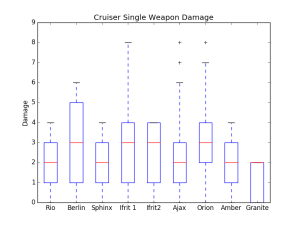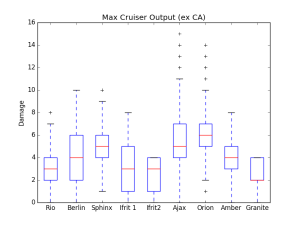So, before I get started, the disclaimer. Damage output of ships is only useful subject to the opportunity to use it. That means range (shaltari, PHR), survivability (UCM, PHR), and the ability to deliver damage before being weakened (Scourge, shaltari) play a critical role in how decisive these stats are.
A big part of my interest in this, was seeing a number of PHR players dismayed at the output of their ships. This article is limited to the two “main” cruisers each faction has, usually one with “conventional” weapons (for that faction) and the other with the “special” weapons for that faction. I used monte-carlo sampling to derive the data (burnthrough mechanics make life hard for binomial maths, and it’s easier to trouble-shoot monte-carlo sampling). The results have then been box-plotted in matplotlib (python).
 This first graph shows the damage output of a range of “standard” cruisers against a target with 3+ armour. 100,000 samples were used for each cruiser, rules like calibre and scald were assumed not to apply. The output is based on using only a single weapons system. The ifrit1 and 2 are the alternative fire modes of it’s furnace cannon. In red you can see the median damage output for each cruiser, which marks that there’s roughly 50% chance of scoring equal to or more damage. This test is a current ‘worst case’ of the much maligned Ajax, which has to deal it’s damage without the benefit of crits. The orion seems to perform on par with burnthrough lasers, having a similar median result.
This first graph shows the damage output of a range of “standard” cruisers against a target with 3+ armour. 100,000 samples were used for each cruiser, rules like calibre and scald were assumed not to apply. The output is based on using only a single weapons system. The ifrit1 and 2 are the alternative fire modes of it’s furnace cannon. In red you can see the median damage output for each cruiser, which marks that there’s roughly 50% chance of scoring equal to or more damage. This test is a current ‘worst case’ of the much maligned Ajax, which has to deal it’s damage without the benefit of crits. The orion seems to perform on par with burnthrough lasers, having a similar median result.
 For this test, the same parameters were used, however the 3+ armour was replaced with a 4+ passive countermeasure. Performance can vary quite dramatically against shields, this is where rules like particle really shine, and critical hits become pointless (without the crippling rule, anyway). Here the Ajax is on par with the Orion, and the burnthrough lasers, and better than any ‘standard’ gun cruiser. Close action weapons are not included here, but it also makes sense that they would perform well against passive countermeasures.
For this test, the same parameters were used, however the 3+ armour was replaced with a 4+ passive countermeasure. Performance can vary quite dramatically against shields, this is where rules like particle really shine, and critical hits become pointless (without the crippling rule, anyway). Here the Ajax is on par with the Orion, and the burnthrough lasers, and better than any ‘standard’ gun cruiser. Close action weapons are not included here, but it also makes sense that they would perform well against passive countermeasures.
 In this graph, we see the potential damage output of weapons free. For the PHR cruisers, this would be quite difficult needing targets to the front and both sides simultaneously. This test excludes close action weapons and scald. What you can see from this picture, is how well damage output correlates with utility. The UCM have the lowest output (ignoring the special case ifrit and granite) on weapons free, but are perhaps the easiest to use the order with. The PHR absolutely dominate the peak damage potential, assuming you can get your broadside in position..
In this graph, we see the potential damage output of weapons free. For the PHR cruisers, this would be quite difficult needing targets to the front and both sides simultaneously. This test excludes close action weapons and scald. What you can see from this picture, is how well damage output correlates with utility. The UCM have the lowest output (ignoring the special case ifrit and granite) on weapons free, but are perhaps the easiest to use the order with. The PHR absolutely dominate the peak damage potential, assuming you can get your broadside in position..
You have to put this in context as well, the orion is 107pts and the ajax 100pts against 105 for both UCM options. So the ajax is cheaper, has an extra damage point (which is big because it’s also an extra damage point before crippling), extra scan, and otherwise has equivalent statistics, and yet when used perfectly has an insane amount of firepower. When you combine those factors, it looks like the PHR have some really nice boons to offset their dependence on coming about to fire.
So this is also ignoring close action and other statistics. I think the way it’s worded about the PHR is misleading. Sure, the PHR get an extra 2″ over UCM and Scourge in Scan rating and extra Hull but their CAW and PD are meh. Shaltari get low Signature plus big Scan, great PD, high speed. In many ways, low Signature is the best “armour” of all. Scourge have the most raw firepower including their CAW and Scald adds even more to their firepower.
The non PHR factions can more easily manouever and apply their firepower through the crucial front arc as they choose how far forward to move while the PHR have to turn away or try to dive in between the enemy fleet.
Are criticals included in the analysis? I would assume so.
3+ weapons fired on the same layer with no debris have one third of their damage ignore enemy armour. So I personally rate 3+ weapon dice as more powerful than equivalent damage output from more dice of 4+ or 5+ weapon dice. Hopefully this is included in the graphs above.
Also, I believe the rules make it clear that Particle only ignores Armour not Passive Countermeasures. I posted the page numbers and rules sections on Hawk forum recently. It reads quite clearly to me though the rules are in different sections of the book and not laid out particularly well IMO.
Anyway, this is a fantastic analysis. Knowledge is Power! More please. 🙂
Hi Peter, thanks for the comments.
CAW wasn’t included, because for most factions it means coming within 1/3 – 1/2 the operational range. It matters, but it’s (as far as I’m concerned) a totally different tactical part of the game to main armament.
With regard to PD capacity, the PHR have equal PD to the UCM, and only 1 lower than the Scourge. Scourge cruisers have armour 4+, which is MUCH worse than 5 PD, and the worst signatures.
Shaltari PD is amazing, but doesn’t apply when they use shields (which will be nearly every case of close action).
PHR have a probability of 0.66 to score a hit per dice of CAW. Half of them will be crits.
UCM have a probability of 0.5 to score a hit per dice of CAW. A third of them will be crits.
Lets assume most ships can roll 2 successes on PD, aside from shaltari. That’s a high probability roll, but on the conservative side (high estimate).
Across all 3 possible numbers of PHR CAW attacks (2, 3, 4), the average is 70% chance to score 2 or more hits, using binomial mathematics.
Across all 6 possible numbers of UCM CAW attacks, the average is 67% chance to score 2 or more hits, using binomial stats.
Assuming they score 2 hits (not more) from the above:
Taking the (above) average roll of 2 PD value, the PHR have a 75% chance of damaging through the point defense.
Taking the (above) average roll of 2 PD value, the UCM have a 55% chance of damaging through the point defense.
Basically, once again, the PHR don’t have the raw potential of the UCM, but the 3+ to hit with CAW means they are far more reliable. Combine that with the fact that they have an extra 2″ range on all their CAWs, and it’s nothing to sneeze at. The idea that their CAW is a massive flaw, to me doesn’t bear up to scrutiny. Undeniably, Shaltari have the “best” of everything stat-wise, that doesn’t make the PHR weak.
The PHR aren’t totally stuffed in terms of approach, you can come about at the last minute and get the enemy 1 degree into your side arc. And while their burnthrough lasers aren’t as powerful as the UCM, they are included in the 100pts cost of the Ajax. Every UCM cruiser on the other hand, has their BTL as a primary weapon. You can field a surprising amount of them.
Criticals were included in the analysis. 3+ weapons have one half ignore armour, 4+ has a third. It’s all included in the numbers here.
On page 69, the particle rule states that all hits inflict crits “if the lock value of their attack is met and passive saves may not be taken against them”. It’s pretty clear you can’t use shields, in fact the flavour text for the rule states as much.
So far, the ‘common wisdom’ is that PHR is weak. Anecdotally, PHR win second-most to Shaltari, and none of the ‘PHR is weak’ arguments are based on proper statistical methods. They are normally based on the old “take the average for everything” method, which fails spectacularly the less dice you use. I would personally rate the PHR as the second most powerful race. They have enough ‘tricks’ to make missions very hard (bombardment strike carriers, devastating and highly available bombers). They have the second most powerful overall stats, and their ships are very reasonably priced, at least at cruiser tier.
Wonderful! Thanks for the correction about Particle. I totally missed that.